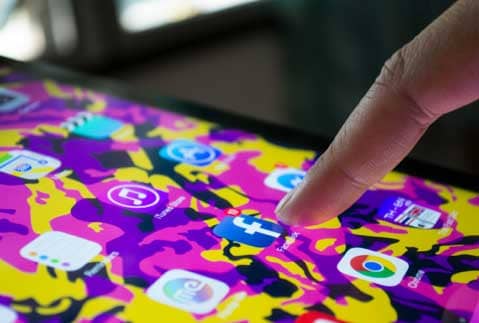Weekly Retail Media Note #166: Social Media Influences Millennials' Purchasing Decisions
Furniture World News Desk on
12/31/2017

Social media channels are now the main sources of news, opinions and debate. According to Shaz Memon writing in HuffPost (032317), ‘logging on and 'liking' are daily interactions. The number of friends and followers you have has become central to personal happiness and professional success. We are social.
Born between the early 80s and early 2000s, millennials live life online. Also known as Generation Y or Generation Me, this is a group that has become defined by the digital world and has prompted the huge cultural shift towards capturing every moment on camera phones, in tweets and Snapchats for the rest of the world to see.’
This has been caused by the death of newspaper, all the world’s a stage and an opinion of out with the old.
The death of newspapers and their reluctance to immediately jump in to the digital and mobile arenas, allowed for social media platforms to explode and take the eyeballs away from them. The ‘all the world’s a stage’ comment is that everyone wants attention to what they have to say. The world today is in fact their stage. And they express it constantly. Then there is the opinion ‘out with
the old’. This can be seen everywhere. They want to throw everybody out (look at the past Presidential election) and they have very little patience with the elderly. They really want noting to do with the past. Therefore, your being in business since whenever, doesn’t play to this audience.
Social media has changed all of that and it rules today.
Social media brings the customer closer to their favorite purchases and has forced business to rethink their entire marketing strategy.
Why do brands spend so much time and effort courting millennials on social media? Andrew Arnold writing in Forbes (122217) noted, ‘Digital marketing is a big undertaking, it can be expensive, and there’s lots of competition. Still, companies seem to be committed to engaging on social media. The simple reason behind this is that it works.
Social media is a major influencer when it comes to the purchasing decisions of millennials. In fact, 72% of them report buying fashion and beauty products based on Instagram posts. And the further role of social media influencers goes way beyond this one network.
Why do brands spend so much time and effort courting millennials on social media? After all, digital marketing is a big undertaking. It can be expensive and there are lots of competition. Still, companies are committed to engaging on social media. The simple reason is that it works.
Engagement not promotion or advertising is often the drive behind purchasing decisions
While influencers and peers may hold the most influence over millennials purchasing decisions, that doesn’t mean that brands don’t have a voice at all. They most certainly do. However, it’s important to keep in mind that they are more impressed by engagement than promotion. Sixty-two (62%) percent of this group states that they are more likely to become brand loyal if a company engages with them, sincerely, on social media. Not only does brand loyalty drive purchasing decisions, it also drives those ever important social media recommendations. Millennials who become particularly bonded to a brand can even be elevated to the level of brand ambassador influencer like 50 North Yachts does.
Businesses that are interested in influencing millennials should certainly use social media to address them. That being said, in order to be successful, it is
imperative that brands recognize exactly how millennials look to social media for information and feedback. It’s not so much promotion and advertising that makes a difference. Instead, this generation values sincerity, peer and influencer recommendations, and values.
Peer recommendations carry a lot of weight with millennials
As mentioned above, recommendations from peers can reap a lot of customer conversions. According to Hubspot, 71% of people are more likely to make a purchase online if the product or service comes recommended by others. This may be driven by millennials inherent distrust of brands and traditional advertising. They simply tend to believe what their peers say, seek their opinions and often validation.
However, according to McKinsey, a small number of influencers are accountable for the lion’s share of referrals brands receive via social media. For example when studying products such as shoes and clothing, it was discovered that 5% of the influencers offering product recommendations were driving 45% of social influence. They have earned the trust of their followers as a result of establishing expertise or other influence in a very specific niche. According to entrepreneur Andrew Molz, in order to reach millennials, brands should focus on earning those referrals and recommendations. Molz built a Shopify based website and generated $2.2 million in sales using only social media to generate traffic.
Fashion is now driven by influencers on social media
“Industry influencers in niches such as fashion and beauty hold a lot of sway over this consumer group,” Molz said. They start trends, determine what’s cool and desirable, and curate the must-have items as fashion magazines used to do.” For instance, last August, 80% of Nordstrom’s mobile traffic came from a single influencer, RewardStyle Network. This same influencer network also drove 21.94% of Sephora’s traffic, 34% of traffic to Revolve.com, and 30.83% to Net-A- Porter. This means, Molz argues, that “companies must recognize who has the ear of the millennials in their target audience. This includes bloggers and vloggers, publishers, YouTubers, etc. Getting their seal of approval could be key in pushing millennials further into the sales funnel.”
The influence goes way beyond fashion too. For example, the release of the video game overwatch was highly anticipated. A week after its release, Elon Musk tweeted that he liked the game and congratulated the publisher on a job well done. That casual, likely offhand remark generated over 3800 retweets and resulted in 12,000 instances of engagements. This happened in only minutes.
User generated content has a big influence on purchasing decisions
According to Gartner research, 84% of millennials are likely to be influenced to make a purchase based upon user generated content that is created by strangers. While many brands are already using user generated content to increase their followers and further branding, Molz says this can act as additional motivation to encourage followers to share content such as reviews, images, and stories. “Seeing a product in use or simply reading personal stories from other consumers clearly has a big influence on this consumer group,” he added. When a user takes user generated content to a new level, they become brand ambassadors. These “power users” can help you to take your brand onto the next level. For instance, Covergirl has worked to create relationships with popular beauty vloggers James Charles and Nura Afia. By working with Afia specifically, the brand stands to capture the interests of Muslim women who may have previously felt ignored by the cosmetics industry. That’s significant as it is predicted that Muslims will spend between 464 and 730 billion dollars on fashion and beauty products and services by 2019.’
A number of months ago, a client, during one of our weekly ‘Next Week’s Topics’ meeting said he didn’t believe that there was one case where social media proved it could draw sales. While he did admit that both traffic and sales were up, he wanted to see proof that social media actually was working.
That very day, after our meeting had ended and we were walking the floor, a woman had actually walked into his retail store and bought an entire living room full of furniture. The client saw this, went over and asked what drove her into the store to buy today. She didn’t say a thing, and put her mobile unit in front of him to a post on Facebook we had posted on his behalf. Then she said, ‘That’s why?’.
Retailers, manufacturers, brands of all kinds can no longer claim that social media does not work. It works. And for those who use it as a major play in their marketing budget, social media works above expectations.
Social Media Influences Millennials' Purchasing Decisions
By Lance Hanish
Lance Hanish is Co-Founding Partner in CNA|Sophis Integrated Marketing Solutions one of the leading marketing firms serving the home furnishings industry. An award winning writer, director, producer and advertising/ marketing consultant, he can be reached at:
(480) 619-8999
eMail: Lance@CNASophis.com
Facebook: https://www.facebook.com/CNASophis
Twitter: https://twitter.com/sophis1234
On Google+:https://plus.google.com/+cnasophis
On LinkedIn:Lance Hanish http://bit.ly/2j5yUJS
On Pinterest http://pinterest.com/sophis1234/
MOBILEFirst is a trademark of CNA|SOPHIS Integrated Marketing Innovation 2017
For more information regarding Integrated Marketing Innovations, read Media Notes Canonical at http://www.cnasophis.com.
For daily media notes, read our blog at http://overtheshouldermedia.wordpress.com.
For weekly Media Notes Briefs, read our blog at http:// sophis1234.tumblr.com.
For more information on CNA | SOPHIS, simply scan the QR Code below on your smart mobile device.
